We are going to take a tour through the tiles of the Alhambra, will you join us?
Starting from the entrance to the Nasrid Palaces, we will walk through each room. We will see the most interesting tile panels in each room. We will explain some curiosities and give you a glimpse of their history.
What you will find here
TRIP THROUGH THE TILES OF THE ALHAMBRA
We warn you in advance that it would be impossible to describe all the tiles of the Alhambra in post format, it would take us a book, or two! We will make a tour of the most significant ones in each place.
AT THE END OF THE TOUR, SOME KEYS ON TECHNIQUE, COLOUR AND SYMBOLISM.
MEXUAR’S TILES
Our journey begins at the Mexuar. This is where the Sura or Council of Ministers met and where the sultan dispensed justice. The space was profoundly changed with the arrival of the Christians who built a chapel. In fact, the present room probably had a courtyard with cupboards where perfumes were kept. We are referring to the space where the choir was later located (between the oratory and the access to the Mexuar). The tiling of this ancient courtyard is one of the most interesting in the Alhambra. They form enormous wheels with small pieces made from 8 and 16 star-shaped tiles.
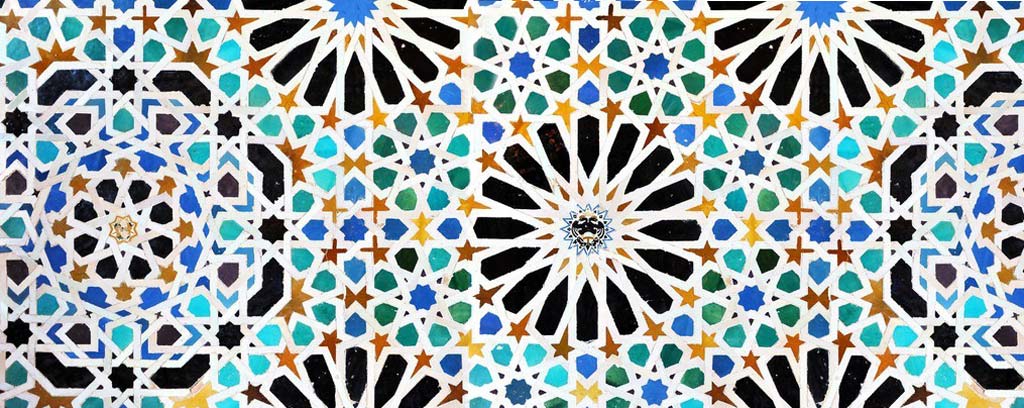
Mexuar tiles with complicated taped wheels and Christian symbols in the sinos (stars).
The rest of the tiles in the room are Moorish (Muslims converted to Christianity from 1502). They are part of the Christian adaptation of the space in the 16th century. The level of complexity is much lower, but the result is equally original.
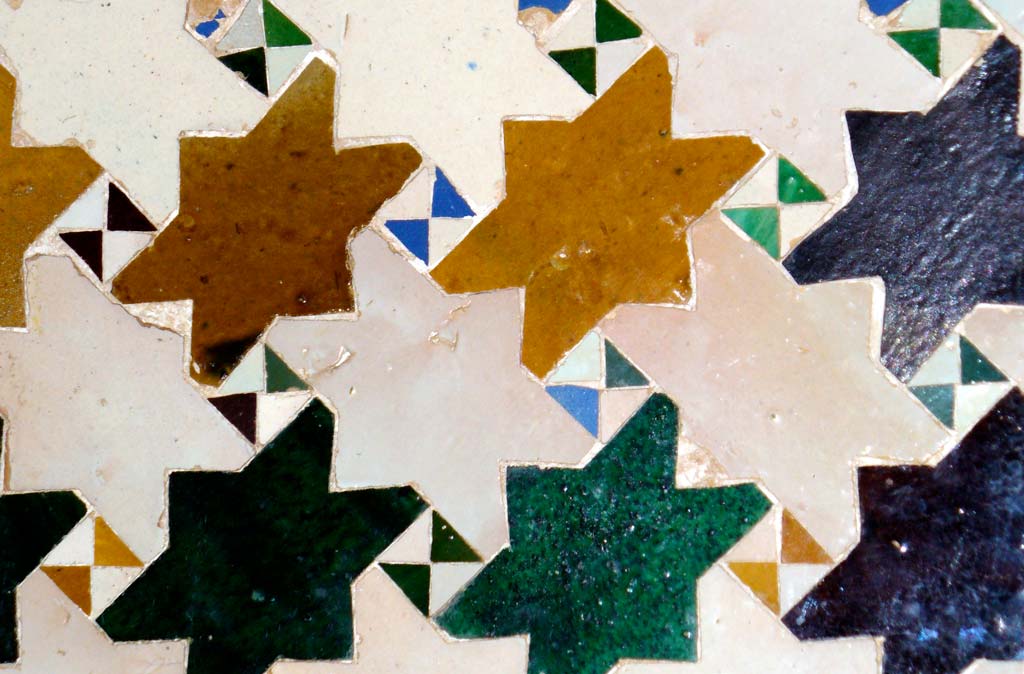
Moorish tiling panel from the Mexuar.
THE GOLDEN ROOM
Through a small door we enter the antechamber of the Golden Room. We are now in the portico that precedes this room. Its plinths are covered with a very simple pattern of 45-degree lozenges. Most of these tiles are not original. What is most striking here are the tiles that line the shafts of the columns attached to the wall. They form a network of lozenges or sebka that is repeated in several places in the Alhambra. It is an example of how a single motif can be extended to infinity.
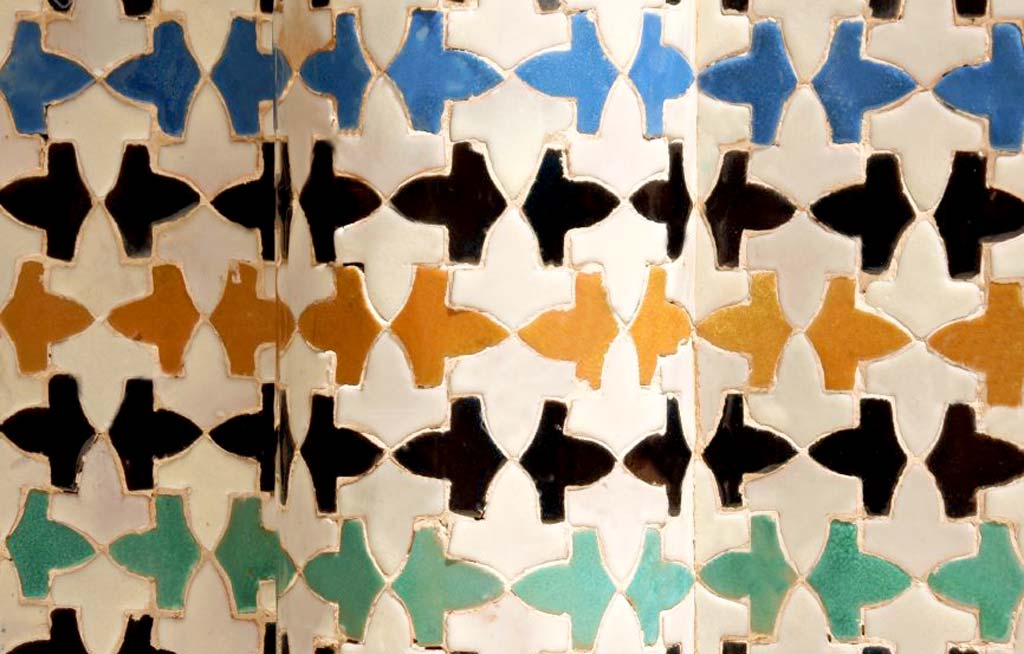
Sebka tiling on the shafts of the portico of the Golden Room.
TILES OF THE FACADE OF COMARES
Going out into the courtyard of the Golden Room, we come across the Façade of Comares. This great scenography accompanied the sultan. Here he would appear on his seat in the centre of the courtyard. Under this façade he received important audiences. It is one of the great masterpieces of Hispano-Muslim art where symmetry organises even the smallest detail.
The two entrance doors are framed with tiled work. Thin ribbons of different colours intertwine. The lower part, which is at eye level, is a 19th-century restoration. It was reconstructed with plaster to give a complete view of the decoration. In the lower part you will see tiny ceramic pieces that reproduce an epigraphic text. The fact that they are embedded in plaster is due to the fact that they are part of a contemporary restoration solution.
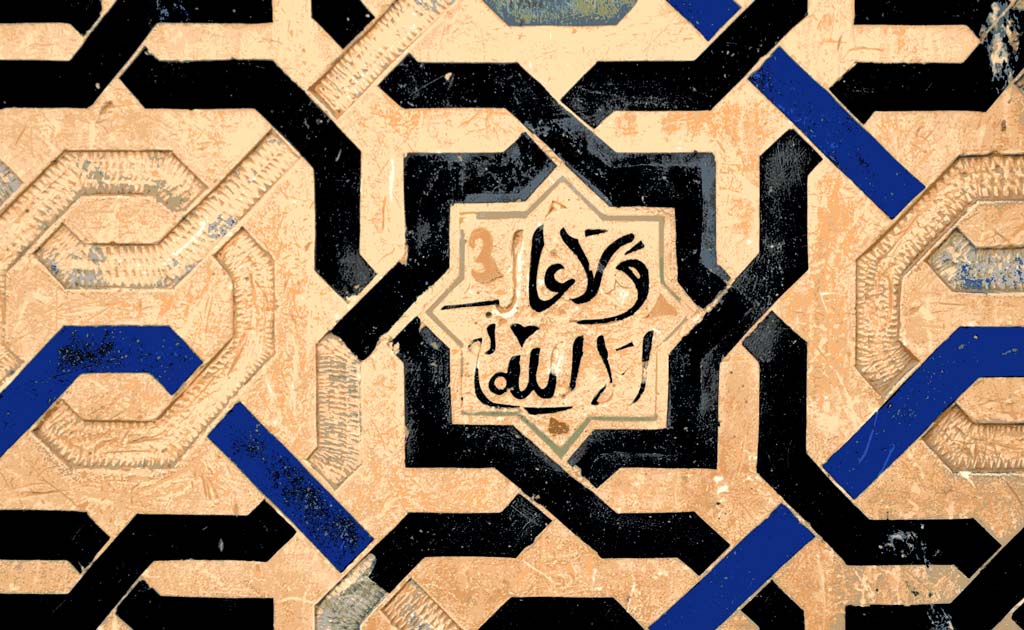
Stylistic restoration of the tiling of the Façade of Comares in the Alhambra.
TILINGS OF THE PATIO OF THE ARRAYANES
We go through the left door and follow a curved corridor to reach the Myrtle Courtyard. We now pass from the administrative and public sphere to the familiar and private one.
This palace was begun by Yusuf I, but his son Muhammad V gave it its “current” appearance. And we say “present-day” in inverted commas because in addition to the Christian transformations it has suffered from fires. As usual, it is organised around a courtyard with a pool and vegetation.
The plinths of the north and south galleries are decorated with the same type of tiles. They are a weave of large pieces taped together and turned at 45º giving the impression of a rhomboid pattern. Virtually all are contemporary restoration pieces.
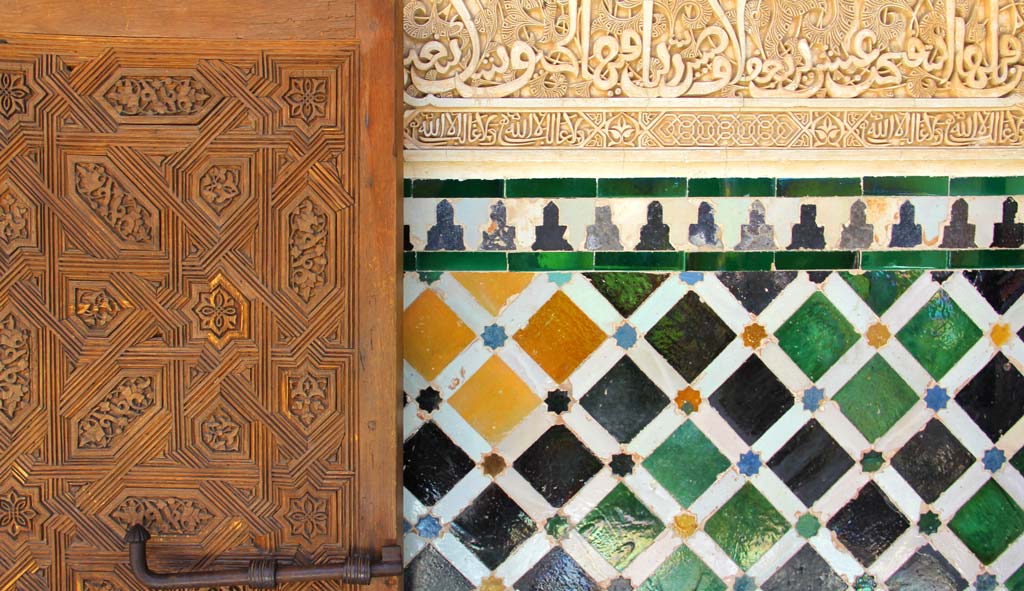
In a single image geometric decoration in tiles, plasterwork and wood.
The iwans of Comares deserve more attention, as here original parts are preserved. They also have a much more complex pattern of tiling, the so-called trisqueles or pajaritas. They form a kind of swastika or moving star. Some researchers consider that this model evokes the movement of water (the relationship of water with the Alhambra is explained in this guided tour). The composition is finished off with a frieze of battlements and merlons in black and white, something almost systematic in the tiling. These are perhaps the Alhambra tiles that we like the most.
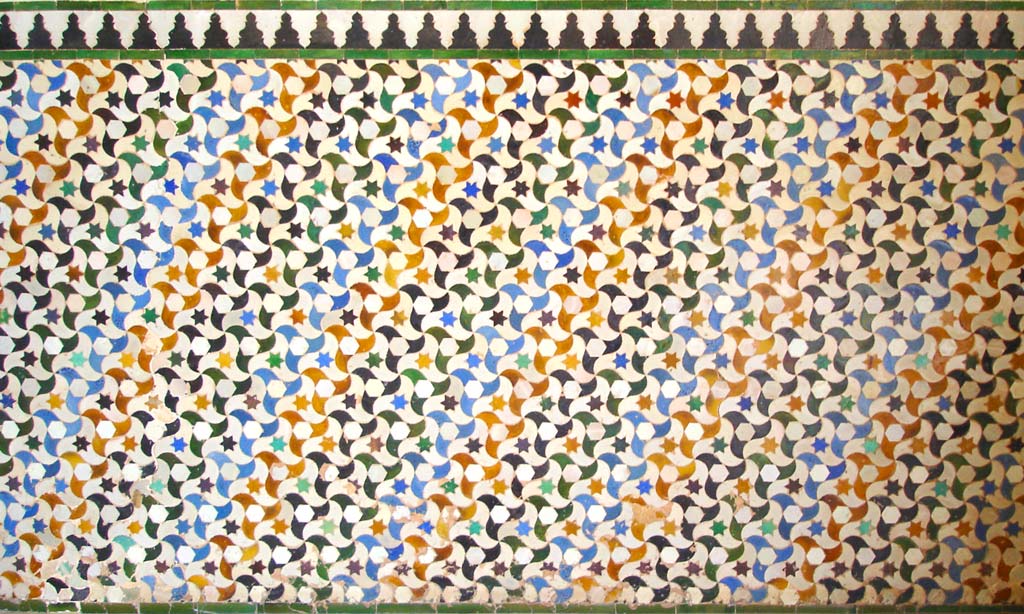
Tiling of the iwans of the courtyard of Arrayanes, one of the most striking and unique forms of the Alhambra.
The function that these iwans fulfilled has not been revealed by any historical source. It has therefore given rise to the imagination and their shelves have been conceived to house lamps, books or other everyday items. The romantic vision of the palace understands the iwans as spaces for resting among cushions and carpets, and this is probably not far from the truth.
VARIETY OF TILES IN THE BOAT HALL
Before reaching the Throne Room we cross the Barca Hall. It seems that its name derives from baraka (blessing, a word that appears frequently in its inscriptions). This room and the outer portico suffered the biggest of the four fires in the Alhambra. It occurred in 1890 and destroyed most of the roofs.
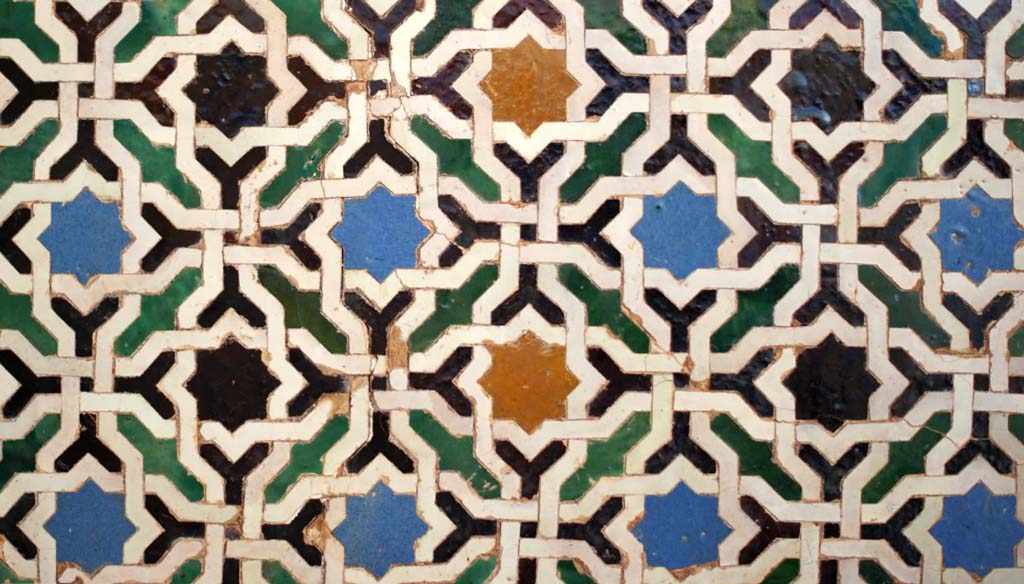
Tiled panel of the Sala de la Barca. Simple, elegant and functional.
Here you will find various types of tiling. On columns and plinths, two different types of sebkas made of black and white pieces were used. On another plinth, panels were mounted with a predominance of taped 8-pointed stars. If we approach the alhanías on both sides we see compositions around larger octagons.
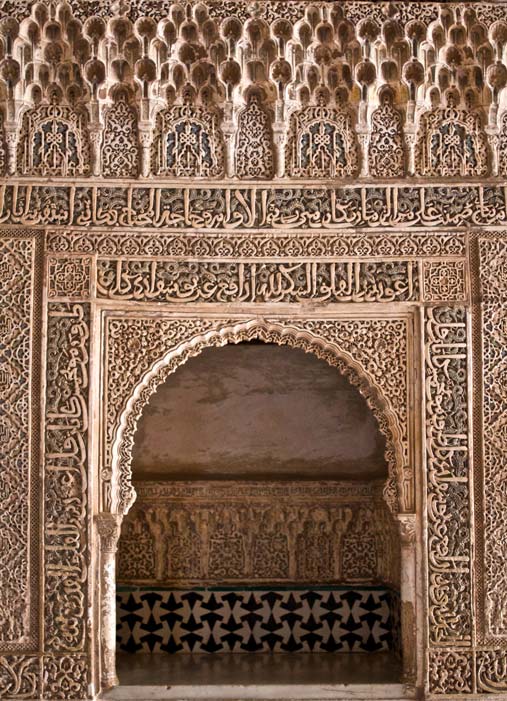
Small panel at the back of the access taqa to the Throne Room. Motif of “The Plane”.
LITTLE TILED PANELS OF COMARES TAQUES
We are almost inside the Throne Room, but it is worth stopping at the taqas. These are the small niches that you will see on either side of the jambs. There are also niches in the passage from the outer portico to the Sala de la Barca. According to the poem in its epigraphy this is where a water jug was placed.
Its interior is also decorated with tiling. The motif in the photo shown here is called “the plane”. It is made up of a single type of piece that is repeated by means of rotations. The pattern could be repeated ad infinitum by alternating black and white pieces.
THE COMPLEXITY IN THE THRONE ROOM
Now we enter the Throne Room or Ambassadors. It is located inside the great tower of Comares. Although its wooden ceiling is perhaps the most significant feature, the variety of tiling patterns here is mind-blowing.
In the 9 small rooms around the living room, the compositions and colour combinations vary. You will find the theme of “the bone”, “the flying fish” (a type of sebka), classic sebkas (rhomboid patterns of mixtilinear lines) and other compositions that are generally simpler.
In our opinion (and only a matter of taste) the most beautiful are the ones on the plinth of the main room. Starting from an eight-pointed star, they develop a large central wheel. From there they vary their development and add more or less wheels.
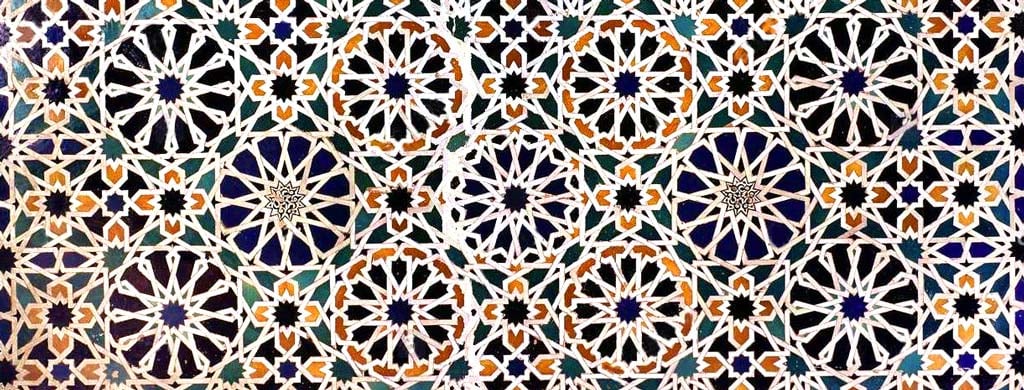
Tiling of the Throne Room or Ambassadors.
Let us now look at the floor, right in the middle of the hall. This is where the sultan’s throne was to be placed. And although it is enclosed so that the pieces are not stepped on, the tiles are not the medieval ones. Now we see some octagonal tiles that imitate the originals and are the product of a restoration carried out at the end of the 16th century. These pieces are known as “de arista”, and have a little relief that was obtained with a mould. The Nasrid coat of arms with the motto “God alone is victor” stands out.
The originals are kept in the Alhambra Museum and date from the 14th century. They were made using the metallic lustre technique. In other words, after the first firing of the clay with the white and blue glazes, a second firing was carried out to apply the gilding.
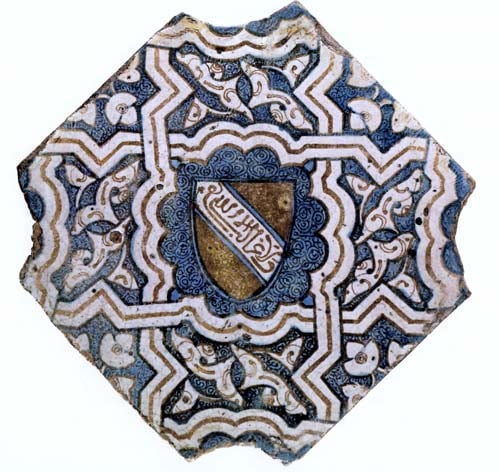
Tiles from the original 14th-century floor of the Throne Room in the Alhambra (Digital Database of Medieval Iconography. Universidad Complutense de Madrid).
ARISTA TILES IN THE QUBBA DE ABENCERRAJES
We continue our tour of the tiles of the Alhambra and take a leap to the Hall of the Abencerrajes. We are now in the Palace of the Riyad al-Said or Happy Garden, better known as the “Palace of the Lions”. This qubbah, along with the rest of the palace, were built under Muhammad V. However, the tiles that cover its plinths date from the 16th century. They have a motif of eight-pointed stars and crosses that combine white, green and honey-coloured (brown) glazes. They are made using the edge technique mentioned above.
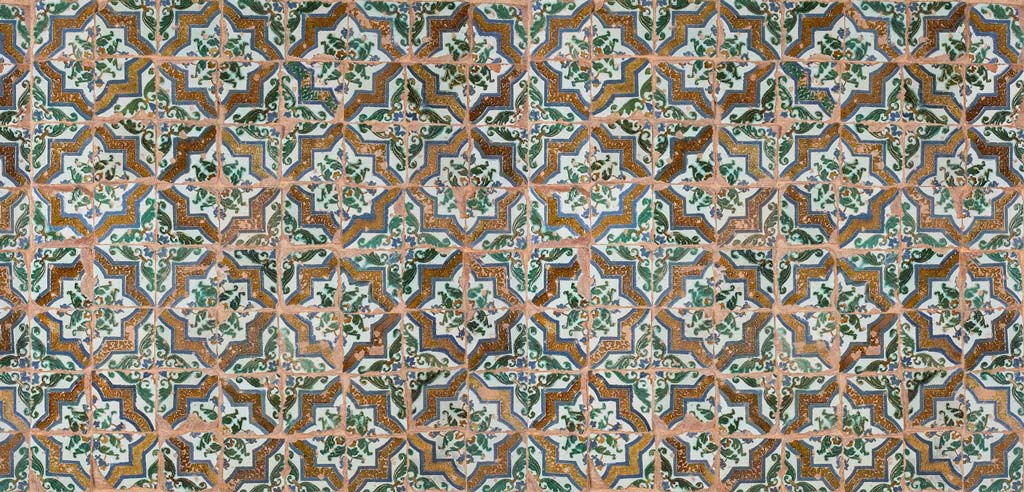
16th century Sevillian groin tiles in the Sala de los Abencerrajes.
The development of this technique took place in the Mudejar Seville around the 15th century. In fact, these were made in Seville. The application of moulds to the clay generates an edge that separates the different shades of glaze.
As a curiosity, this type of tile was also used for the roofs of some buildings. It is not uncommon to find them reused on the balconies of some houses in Granada.
If you look at the floor of the alhanías you will see a herringbone tile pavement. This is not the original, either, but in this case similar floors were made in the Nasrid period.
INCRUSTATION TILES IN THE ROOM OF THE KINGS
We continue our tour through the palace of the Happy Garden until we reach the Hall of the Kings. This space was conceived as a place for recreation, socialising and even partying. The tiling of the skirting boards is not the most important thing in this room. They are largely reconstructed, albeit from original remains. The value of this group of rooms lies in the vaults decorated with figurative representations.
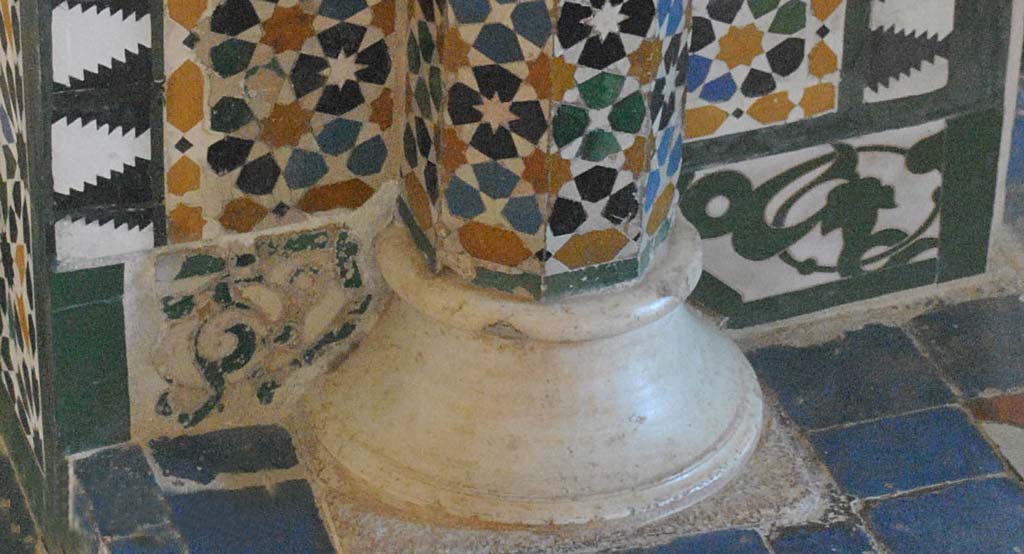
Baseboards of the Kings’ Hall in the Alhambra (©️ Paula Sánchez and Manuel Pérez).
However, as this is about tiles, we recommend looking at the skirting boards preserved in some parts of the Hall of the Kings. In particular, the pieces that surround the bases of the attached columns. These are the so-called inlay tiles. On a green tile, a hollow is carved into which white pieces are then inserted. In this case the compositions move away from the geometric. They show a plant theme of thin stems and palms. A similar solution can be found in some monumental gates such as that of the Armas in the Alcazaba and in the lintel at the entrance to the Generalife.
LACERIA TILES OF THE QUBBA DE DOS HERMANAS
We now enter the second residential space of Leones, the Hall of Dos Hermanas. Everything is significant in this qubba: the plasterwork, the latticework, the colour and the two gigantic marble slabs that give the room its name.
The plinths are covered by thousands of elongated pieces or “ribbons” that intertwine. Here you can lose yourself to infinity by following the complicated lacerations of the skirting boards. Something almost incomprehensible to the common human eye and that only mathematics can explain.
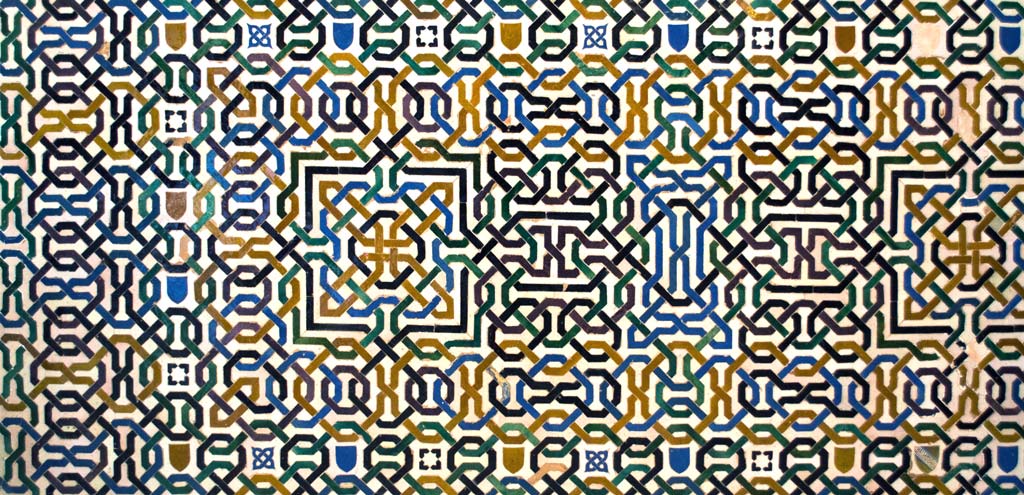
Tiled panel of lacquerwork, most of the pieces are interlocking “ribbons”.
But to mark the difference with what we have seen so far, here several fragments of pavement with the tiling technique are preserved. They can be found at the entrances to the different rooms or alhanías. Although it was common to carry out this work, the floor tiles are one of the elements that are most affected by the passage of time and must be renewed.
MORE INCRUSTATION IN THE MIRADOR DE LINDARAJA
A few steps further on we come to the Mirador de Lindaraja or Daraxa. Originally it would not overlook the current 16th century courtyard, but would have views towards the wall and the Albaicin. If the spaces seen so far were already overloaded, here the detail of the decoration reaches even greater heights. The most unique feature of this space is the wooden ceiling with shards of coloured glass.
But let’s focus our gaze now on the jambs of the great archway leading to the belvedere. Once again we find a small frieze of inlaid tiles. In this case we see an Arabic inscription in black on a white background. The black pieces would be the inlaid ones and praise the builder of the palace. The epigraphy on the right jamb reads: ‘Divine help, dominion and clear victory be to our lord Abū ‘Abd Allāh (Muḥammad V), prince of the Muslims’. The inscription on the left reads: “Glory be to our lord Sultan Abū ‘Abd Allāh (Muḥammad V), son of our lord Sultan Abū l-Ḥaŷŷāŷ (Yusūf I).
BATH TILES FROM COMARES
This is the best-preserved hamman of al-Andalus. However, it was restored in the 19th century and a large part of it was replaced with modern tiles. The brightly coloured plasterwork in the Sala de las Camas is often impressive. Although they are part of the reconstruction, they evoke their original appearance. It was the private bath of the Nasrid sultans and related aristocrats.
The variety of geometric patterns and chromatic combinations is enormous. Ceramic tiles cover almost all of the attached columns, floors and skirting boards. Once again, we find tiling of very large pieces with simple and infinite compositions. A composition of elongated pieces that, curiously, are used both vertically and horizontally, stands out.
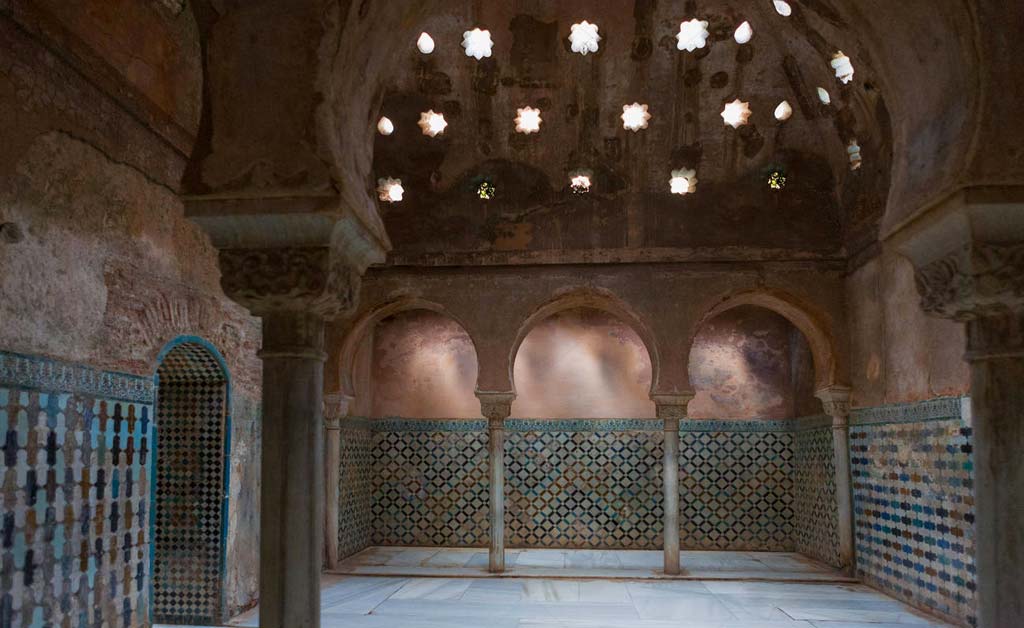
On the left and right of the image, the tiling of elongated pieces that we refer to from the Bath of Comares.
Both the Catholic Monarchs and the successive monarchs value the Nasrid heritage, as most of the decorations of the Alhambra are preserved. However, it was given a new meaning by introducing its own symbols such as the “double-headed eagle” and the imperial “Plus Ultra”. The Comares bath is made by inserting small ceramic pieces into the tiling, as in the Mexuar.
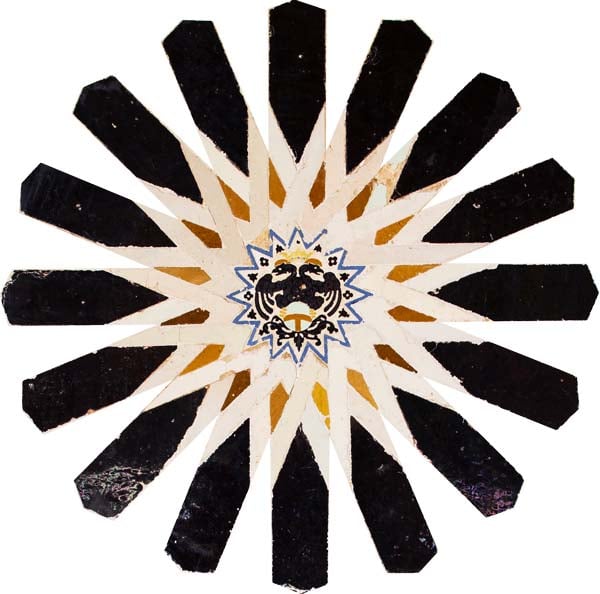
Tiled wheel with the double-headed eagle. Symbol that represents the union of the Holy Roman-Germanic Empire with the crown of Spain. In this case it is part of the decoration of the Mexuar.
The hammam of Comares is only accessible through the Alhambra’s programme of specialist visits. However, there are a couple of places from where it can be seen. One is from the corridor that connects Dos Hermanas with the rooms of Washington Irving; and two, from the basement of the Sala de Dos Hermanas.
PARTY TILES
We have arrived at the Partal, another of the icons of the Alhambra and our last stop. It is built on top of the Alhambra wall and has a large landscaped pool. Although it is visited after the so-called Nasrid Palaces, it was built before almost everything seen so far (Muhammad III between 1302-1309).
The tiling of the tower is based on central stars of 12 or 16 points. They generate the classical wheels composed of the sino (or central star), zafate, almendrilla, alfardón and candilejo. Each and every one of the pieces is taped, that is to say, surrounded by elongated pieces that are interwoven. Despite having complex patterns, the appearance is sober, combining only three shades of glaze: green, black and white.
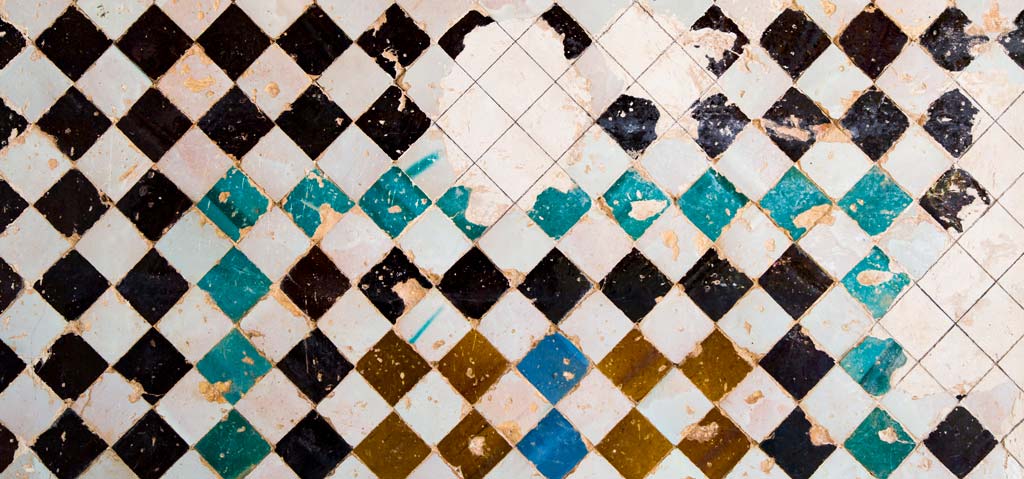
Panel of small tiles from the Partal. The restoration respected the gaps keeping only original tiles.
The portico tiles are much simpler. They reproduce a grid of squares rotated at 45º and crowned, as usual, by the classic merlons.
Our journey ends here, if you liked it, put it in the comments and we will try to make a second instalment with the rest of the route. However, the article continues. We will then talk about the technique, the uses, the symbolism,…
ALL THIS AND MUCH MORE ON A PRIVATE GUIDED VISIT TO THE ALHAMBRA
We organise your visit to the Alhambra. We manage the tickets and guide you to tell you all the stories, legends and details. Get to know our private tour of the Alhambra.
Technique, uses and symbolism of the Nasrid tiles 👇
TECHNIQUE AND USE OF TILES IN THE ALHAMBRA
Tiles are not an invention of the Andalusians. They can probably be found in almost any culture. We only have to go to the Ishtar Gate of ancient Babylon (6th century BC) to find a clear example of this. However, the Andalusians developed this art with enormous mastery to achieve results as surprising and original as those of the Alhambra.
TYPES OF TILES USED IN THE ALHAMBRA
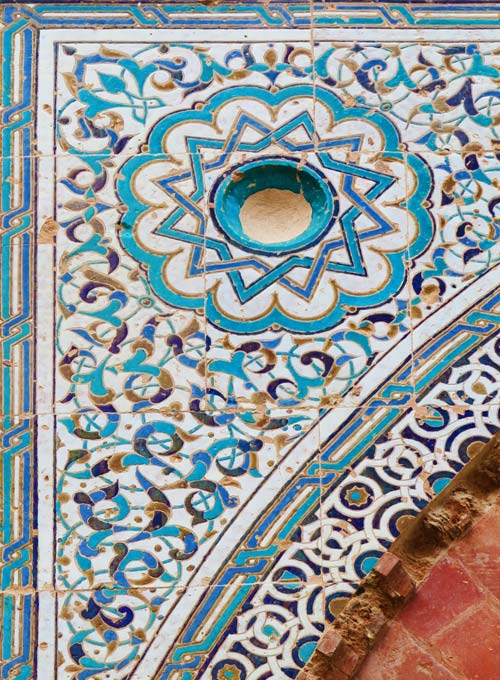
Dry cuerda tiles on the Wine door in the Alhambra.
A review of what we have seen so far, in the Alhambra there are a multitude of decorative solutions with tiles.
- Tile panels. Set of tiles of medium to large size and mainly square in shape.
- Tiles. Set of pieces of different shapes, sizes and colours that are grouped together to form more or less complex geometric compositions.
- Inlay tiles. Carved pieces into which other smaller ceramic pieces are inserted
- Relief tiles. Pieces with varied shapes that have been carved or modelled before the application of the glaze. We have not seen them on the tour, but you can find them at the Puerta de la Justicia.
- Dry rope tiles. Where a manganese line separates the different shades of glaze. We have not seen them either, but it is only necessary to go to the Wine door and look at their spandrels.
- Glazed tiles. Already from the Christian period and imitating dry rope.
To this must be added that the style evolved, especially in terms of complexity and ornamentation.
Each of the pieces of tiling is given a name. Here we show you the main ones.
- Star. They are available from 8 to 16 points. If they are the centre of the composition, they are called “sino”. The more points the star contains, the more complex the wheel formed around it will be.
- Zafate. It can take many shapes, although it usually has 6 sides with one of its corners elongated. The main ones are found radiating from the but, although this is not the norm.
- Alfardón. It is similar to the previous one but more elongate
- Almendrilla (Almond). These are the smallest pieces, usually rhomboidal in shape.
- Candilejo. It is the piece with the greatest morphological variety. It usually has trapezoidal shapes with 8, 10 or 12 sides.
- Tape or ribbon. These are thin pieces that act as a separator between the previous pieces. However, they can also be used for tiling without the need for other pieces. They reproduce criss-cross motifs known as lacemaking.
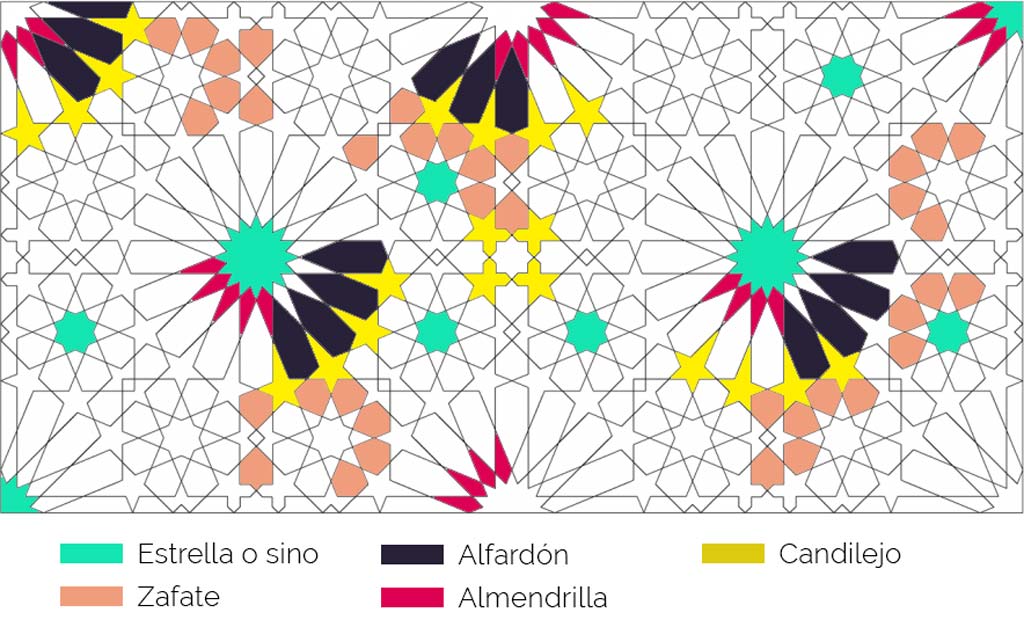
THE TECHNIQUE OF TILING
Although “alicatar” is a word used in Spanish, it comes from the Andalusian Arabic alqáṭ[a]’ and this from the classical Arabic qaṭ’ which means “cut”. In Spanish it has two meanings: “to cover something with tiles” or “to cut or cut the tiles to shape them“.
However, in the Alhambra the term ’tiling’ is only used in its second meaning, i.e. for cut tiles. If the wall has been covered with medium or large square tiles, it is called a tile panel.
Tilings required a previous design endorsed by mathematical connoisseurs. Each piece was carved to size by hand. They were then placed on a board, face down, according to the pre-established design. They were then covered with lime-rich mortar. Once dry and with the help of the board, they were transferred to the wall. Although it seems simple to describe, it is not at all. In this video you can see the painstaking work.
THE USE OF TILES IN THE ALHAMBRA
Protect, decorate and symbolise. These are the three functions of tiles. Glazed ceramic protects against waterproofing and damp. In addition, this material is extremely hard-wearing.
Although tiles dating from before the 13th century have survived, it was from this time onwards that the use of tiles developed most intensively. The use of tiles meant an improvement in production, as clay was an abundant and cheap raw material. The first record in documentary sources of the use of these pieces is provided by Ibn Said in 1240. He recounts that dwellings were decorated with these pieces and that they were produced in Almería, Málaga and Granada.
In the 360º image below we can see how the entire lower part of the Hall of Comares is lined with ceramic tiles. Right in the centre of the floor you can see the Nasrid coats of arms and metallic lustre that we mentioned above.
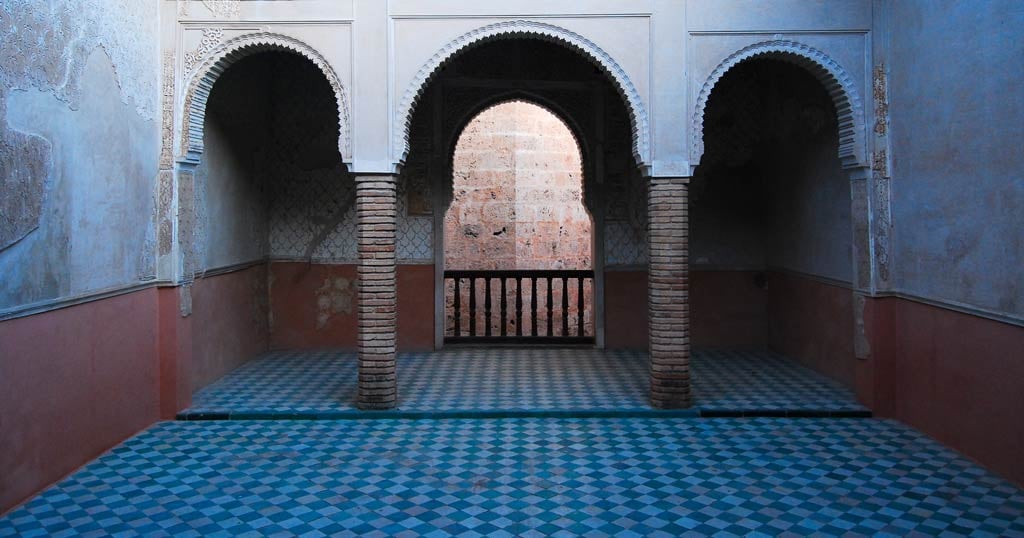
Pavement like a chessboard. Simple and beautiful at the same time.
The tiles are used in pavements, plinths, openings, arch spandrels and, in the Christian period, even in roofs.
THE COLOUR OF THE ALHAMBRA TILES
Are you having a grey day? Come to the Alhambra and fill your day with colour. The palatine city was a multicoloured world. Blue, green, white, honeyed (brown), black and the famed metallic (or gold) lustre were ever-present. Colour was present in the plasterwork, in the textiles that covered walls and floors, in the stone pieces such as lions or capitals and in almost every wooden element (doors, roofs, friezes, corbels, etc).
However most of this colour has been lost. Only ceramic tiles have retained the colour more strongly. They are the only ones that can transport us to the world of Andalusian colour.
This colourful, shiny and even reflective finish was achieved through the glazing of clay slabs.
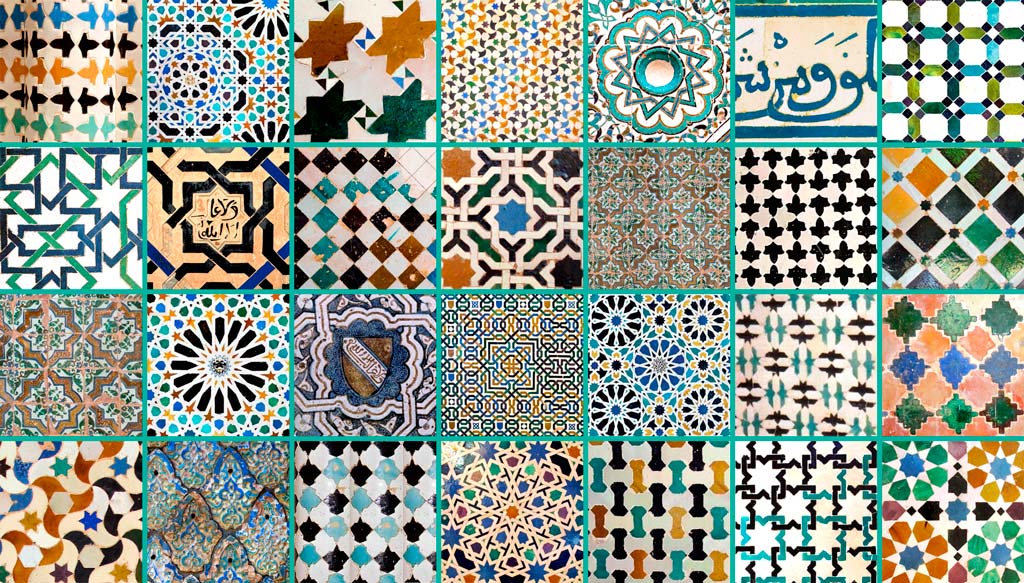
Although not all of them are medieval, all of them belong to the Alhambra.
THE MATHEMATICS OF THE ALHAMBRA TILES
“The number of possible models of flat periodic mosaics is infinite. However, they can be classified by the symmetries they possess into only 17 groups which correspond to the respective Planar Crystallographic Groups. Their knowledge by crystallographers was born after the availability of X-rays around the 19th century. What is truly surprising is that the Alhambra in Granada is the only monumental complex in the world in which all the groups are shown“.
To learn more about the relationship between mathematics and the design of the tiles of the Alhambra, the work of Rafael Pérez Gómez is a must. This professor of the University of Granada has dedicated a great part of his life to the study of mathematics in the Alhambra and has also helped us in the writing of this article.

Breakdown of the planar crystallographic group (© Rafael Pérez Gómez. Computer and Mathematics with Applications, Vol. 14, Issue 2, pp. 133-137, with the title: The four regular mosaics missing in the Alhambra).
SIMBOLISM OF THE ALHAMBRA TILES
But what do these tile patterns represent? The geometric compositions of the Alhambra are perfect and infinite. Geometry symbolises God and is a way of manifesting his presence. Representations of Al-lāh are not permitted in Islam and geometry is a conceptual way of approaching God.
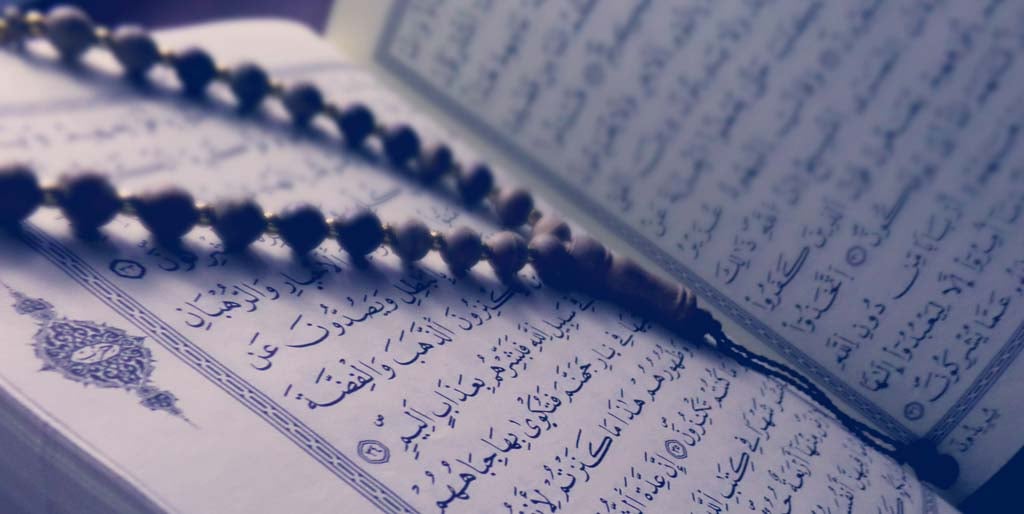
The word of god is recorded in the Koran, but not his image.
The symmetry conveys balance, order and beauty and is the common factor in all the compositions. By means of rotations, translations and repetitions of the pieces, the planes are filled in. This is a complex procedure to which we would like to dedicate an article at a later date.
SOUVENIRS OF GRANADIAN CERAMICS
It is common to find in the shops in the centre tiles with geometric motifs that imitate the Nasrids. We recommend not buying souvenirs because they are usually made of plastic. These are made of ceramic, but they will probably end up in the trash as well. Better to bring a good piece of goat’s cheese, or a bottle of wine from Granada’s bodegas to enjoy in company. Although, beware, there are true tile artisans in Granada who make wonderful pieces.
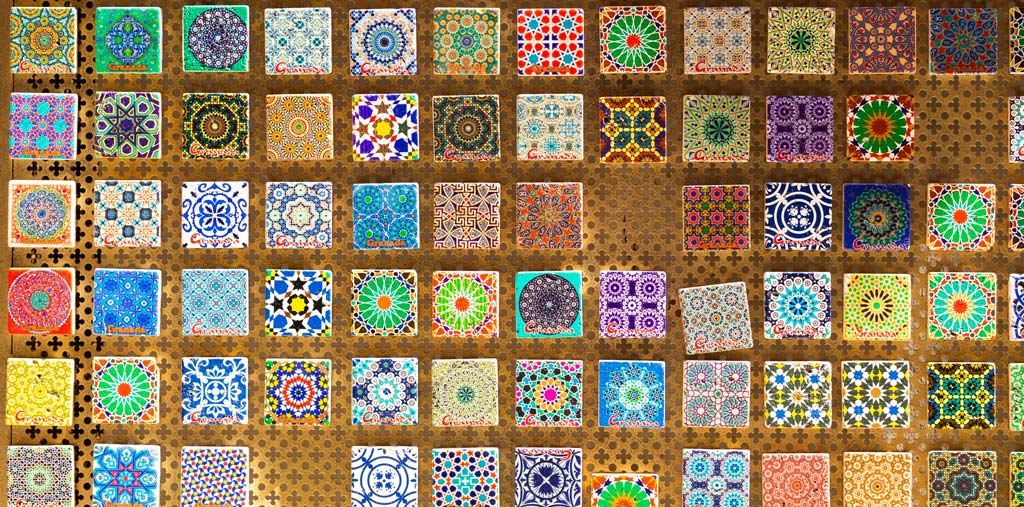
Imported souvenirs. Some of them reproduce Andalusian motifs, other motifs are more related to oriental or even Hindu decorations.
ROUND MAP
With this Google Maps map you can navigate through the tiles of the Alhambra.
BOOK ON THE ALHAMBRA
If you want to learn more about the decorations of the Alhambra, we recommend reading “The Alhambra in Granada. The greatest monument of the Nasrid culture shown in detail“.
If YOU LIKED THIS ARTICLE, we recommend:
THANK YOU
To write this article we have been helped by Paula Sánchez, Gaspar Aranda, Ramón Rubio, Rafael Pérez Gómez, Manuel Pérez. 5 friends who are also specialists in some of the Alhambra’s subjects. To them, a thousand thanks!

